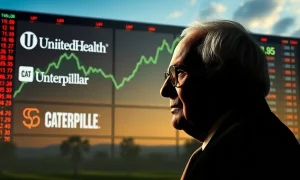Major investment firms often make headlines with their portfolio adjustments. These moves can signal shifts in market sentiment or highlight emerging opportunities. Recently, two prominent hedge funds, Soros Fund Management and Appaloosa Management, significantly increased their positions in **Nvidia stock**. This bold move indicates strong confidence in the semiconductor giant. Furthermore, these firms also acquired stakes in another stock that was previously beaten down but is now experiencing a remarkable rally. Understanding these strategic decisions offers valuable insights into current market dynamics.
Soros and Appaloosa’s Strategic **Nvidia Stock** Boost
Soros Fund Management, founded by legendary investor George Soros, and Appaloosa Management, led by David Tepper, both revealed substantial increases in their **Nvidia stock** holdings during the first quarter. These disclosures, part of their 13F filings, highlight a clear bullish stance on the chipmaker. Nvidia has emerged as a key player in the artificial intelligence (AI) revolution. Its graphics processing units (GPUs) are essential for training complex AI models. Consequently, demand for Nvidia’s products has surged, driving its stock price higher.
Soros Fund Management boosted its **Nvidia stock** stake by an impressive 225%. Its holdings now stand at 133,000 shares, valued at approximately $110 million. Similarly, Appaloosa Management expanded its position by 150%, reaching 1.15 million shares. This translates to a value of over $950 million. These substantial increases reflect a belief in Nvidia’s continued growth trajectory. Both funds evidently view Nvidia as a critical long-term investment.
Nvidia’s performance has been exceptional. The company has consistently exceeded revenue and earnings expectations. This strong financial health underpins investor confidence. Moreover, Nvidia’s innovative product pipeline ensures its leadership in the rapidly expanding AI market. The company’s strategic partnerships and ecosystem development further solidify its market position. Therefore, the decision by these hedge funds to double down on **Nvidia stock** appears well-founded.
Identifying the Beaten-Down Gem: Beyond **Nvidia Stock**
While their increased **Nvidia stock** holdings captured attention, Soros and Appaloosa also made another notable investment. They acquired shares in a stock that had faced significant headwinds but is now staging a robust comeback. This particular company is Micron Technology (MU), a leading semiconductor memory manufacturer. Micron experienced a downturn due to a slump in the memory chip market. However, the outlook for memory chips has improved significantly.
Micron Technology specializes in producing DRAM and NAND memory products. These components are vital for various electronic devices, including smartphones, computers, and data centers. The memory market is cyclical; periods of high demand and prices are often followed by oversupply and lower prices. Micron had navigated a challenging period marked by excess inventory and weak demand. Its stock price reflected these difficulties.
However, recent trends indicate a strong recovery. Demand for memory chips is rebounding, driven by factors such as:
- Increased adoption of AI technologies requiring more memory.
- Growth in data center infrastructure.
- New product cycles in consumer electronics.
These factors have contributed to an improving pricing environment for memory products. As a result, Micron’s revenue and profit forecasts have been revised upwards. The stock has rallied considerably from its lows, signaling a potential turnaround. Both Soros and Appaloosa likely recognized this inflection point, seizing the opportunity to invest in a company poised for recovery. Their timing appears strategic, aiming to capitalize on the early stages of a market upswing.
The Rationale Behind These **Hedge Fund Investments**
Understanding why Soros and Appaloosa made these specific investments requires examining their broader investment philosophies. Both funds are known for their active, high-conviction strategies. They seek out companies with strong fundamentals or those undergoing significant positive changes. Their recent moves in **Nvidia stock** and Micron Technology align with these principles.
For **Nvidia stock**, the rationale is clear: it represents a high-growth play on the AI megatrend. Nvidia possesses a dominant market share in AI accelerators. Its technology is fundamental to advancements in machine learning and deep learning. Investors anticipate continued rapid expansion in this sector. Therefore, increasing exposure to Nvidia allows these funds to participate directly in this transformative technological shift. They are betting on sustained innovation and market leadership.
The investment in Micron Technology, conversely, represents a value and cyclical play. Micron was undervalued during its downturn, despite its essential role in the tech ecosystem. As the memory market improves, Micron stands to benefit significantly from increased demand and higher prices. This type of investment requires a keen understanding of market cycles and the ability to foresee a recovery before it becomes widely apparent. It is a classic example of buying a ‘beaten-down’ asset with strong recovery potential. These **hedge fund investments** often target companies that are temporarily out of favor but possess robust underlying businesses.
Broader Implications for Tech and **Nvidia Stock**
The investment decisions of major hedge funds often have ripple effects across the market. When firms like Soros and Appaloosa make significant moves, other institutional and retail investors take notice. Their increased positions in **Nvidia stock** reinforce the narrative of AI’s transformative power. This can encourage further investment into the broader semiconductor and AI sectors. It also signals confidence in the long-term viability of these technologies.
For the tech sector as a whole, these investments suggest a continued focus on innovation and growth. Companies at the forefront of AI, cloud computing, and advanced semiconductors are likely to attract further capital. The emphasis on both a high-growth leader like Nvidia and a cyclical recovery play like Micron illustrates a diversified approach. This strategy seeks to capture returns from different market segments. It also highlights the importance of fundamental analysis in identifying both growth opportunities and undervalued assets.
Furthermore, the continued strength of **Nvidia stock** could inspire further innovation within the AI hardware space. Competitors may intensify their efforts to develop alternative solutions. However, Nvidia’s established ecosystem and R&D capabilities provide a significant competitive advantage. The market’s reaction to these hedge fund disclosures often leads to increased trading volume and price momentum for the involved stocks. Therefore, these investments are not just about portfolio adjustments; they are also signals to the wider investment community.
Navigating Volatility: Lessons from **Top Investors**
The investment strategies employed by Soros and Appaloosa offer valuable lessons for all investors, particularly in navigating volatile markets. Firstly, they demonstrate the importance of conviction. Both funds made substantial bets on their chosen companies. This indicates a deep belief in their investment theses. Secondly, they showcase the power of long-term vision. While markets can be unpredictable in the short term, fundamental strength and technological trends often prevail over longer periods.
Consider these key takeaways from their actions:
- Deep Research: These funds conduct extensive due diligence. They analyze market trends, competitive landscapes, and company financials thoroughly.
- Strategic Allocation: They balance high-growth potential with value opportunities. This diversification helps manage risk.
- Market Timing: While not always perfect, their ability to identify inflection points (like Micron’s recovery) is crucial.
- Patience: Successful investing often requires holding positions through market fluctuations, especially for long-term trends like AI.
For retail investors, these examples underscore the benefits of a well-researched, diversified portfolio. Do not simply follow large investors blindly. Instead, understand the underlying reasons for their moves. The confidence shown in **Nvidia stock** and Micron Technology reflects a sophisticated approach to capital allocation. It involves both riding powerful trends and identifying undervalued assets. Ultimately, these **top investors** provide a blueprint for strategic decision-making in complex financial markets.
The significant increases in **Nvidia stock** holdings by Soros Fund Management and Appaloosa Management underscore the ongoing bullish sentiment towards artificial intelligence. Simultaneously, their investment in a rallying beaten-down stock like Micron Technology highlights a keen eye for value and cyclical recovery. These strategic moves by prominent hedge funds offer crucial insights into current market trends and future growth areas. They demonstrate a sophisticated approach to portfolio management, balancing high-growth opportunities with undervalued assets. Investors can learn from these actions, focusing on thorough research and a balanced investment strategy in today’s dynamic market.
Frequently Asked Questions (FAQs)
Q1: Why are Soros and Appaloosa investing heavily in Nvidia stock?
A1: Soros and Appaloosa are investing heavily in **Nvidia stock** primarily due to Nvidia’s dominant position in the artificial intelligence (AI) sector. Nvidia’s GPUs are critical for AI development, leading to high demand and strong revenue growth. These funds anticipate continued expansion in the AI market.
Q2: What is the ‘beaten-down stock’ mentioned in the article?
A2: The ‘beaten-down stock’ referred to in the article is Micron Technology (MU). It is a leading semiconductor memory manufacturer that experienced a downturn but is now rallying due to an improving memory chip market outlook.
Q3: What does a ’13F filing’ mean for investors?
A3: A 13F filing is a quarterly report submitted by institutional investment managers with over $100 million in assets to the SEC. It discloses their equity holdings, providing transparency into their investment strategies and allowing other investors to see what major funds are buying and selling.
Q4: How do hedge fund investments impact the broader market?
A4: Hedge fund investments, especially from prominent firms like Soros and Appaloosa, can significantly impact the broader market. They often signal confidence in specific sectors or companies, potentially influencing other institutional and retail investors to follow suit, leading to increased trading volume and price movements.
Q5: What lessons can retail investors learn from these hedge fund moves?
A5: Retail investors can learn several lessons, including the importance of deep research, strategic portfolio allocation (balancing growth and value), understanding market cycles, and exercising patience. These funds demonstrate the value of conviction in well-researched investment theses rather than chasing short-term trends.
























